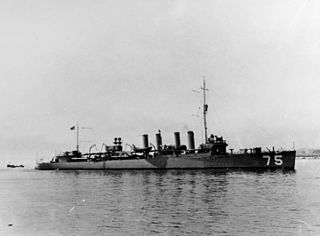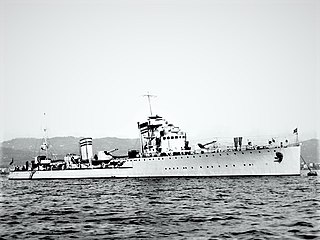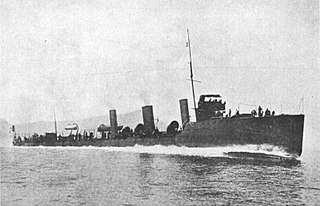
HMS Imperial was one of nine I-class destroyers built for the Royal Navy during the 1930s. She was scuttled by HMS Hotspur in 1941 after she had been crippled by Italian bombers.

HMS Kandahar (F28) was a K-class destroyer built for the Royal Navy during the 1930s, named after the Afghan city of Kandahar.

The Benham class of ten destroyers was built for the United States Navy (USN). They were part of a series of USN destroyers limited to 1,500 tons standard displacement by the London Naval Treaty and built in the 1930s. The class was laid down in 1936-1937 and all were commissioned in 1939. Much of their design was based on the immediately preceding Gridley and Bagley-class destroyers. Like these classes, the Benhams were notable for including sixteen 21-inch (533 mm) torpedo tubes, the heaviest torpedo armament ever on US destroyers. They introduced a new high-pressure boiler that saved space and weight, as only three of the new boilers were required compared to four of the older designs. The class served extensively in World War II in the Atlantic, Mediterranean, and Pacific theaters, including Neutrality Patrols in the Atlantic 1940-1941. Sterett received the United States Presidential Unit Citation for the Battle of Guadalcanal and the Battle of Vella Gulf, and the Philippine Republic Presidential Unit Citation for her World War II service. Two of the class were lost during World War II, three would be scrapped in 1947, while the remaining five ships would be scuttled after being contaminated from the Operation Crossroads atomic bomb tests at Bikini Atoll in the Pacific.

The Wickes-class destroyers were a class of 111 destroyers built by the United States Navy in 1917–19. Along with the 6 preceding Caldwell-class and 156 subsequent Clemson-class destroyers, they formed the "flush-deck" or "four-stack" type. Only a few were completed in time to serve in World War I, including USS Wickes, the lead ship of the class.

The General Electric LM2500 is an industrial and marine gas turbine produced by GE Aviation. The LM2500 is a derivative of the General Electric CF6 aircraft engine.

The Smith-class destroyers were the first ocean-going destroyers in the United States Navy, and the first to be driven by steam turbines instead of the reciprocating engines fitted in the sixteen earlier and much smaller torpedo boat destroyers ordered in 1898. Flusser and Reid are sometimes considered to be Flusser-class ships. Also, since Flusser was completed first, some period documentation refers to the entire class as Flussers.

Four destroyers in the United States Navy comprised the Cassin class. All served as convoy escorts during World War I. The Cassins were the first of five "second-generation" 1000-ton four-stack destroyer classes that were front-line ships of the Navy until the 1930s. They were known as "thousand tonners" for their normal displacement, while the previous classes were nicknamed "flivvers" for their small size, after the Model T Ford.

The Benson class was a class of destroyers of the U.S. Navy built 1939–1943. The thirty 1,620-ton Benson-class destroyers were built in two groups. The first six were authorized in fiscal year 1938 (FY38) and laid down at Bethlehem Steel, Quincy, Massachusetts and three naval shipyards. The remaining 24 “repeat Bensons” were authorized in 1940–42 and built at four Bethlehem Steel yards. They were laid down after the first group was commissioned. These plus the “repeat Livermores” were also known at the time as the Bristol class. During World War II the Bensons were usually combined with the Livermores as the Benson-Livermore class; this persisted in references until at least the 1960s. In some references both classes are combined and called the Benson class. The Benson- and Gleaves-class destroyers were the backbone of the pre-war Neutrality Patrols and brought the action to the enemy by participating in every major campaign of the war.

The Gleaves-class destroyers were a class of 66 destroyers of the United States Navy built 1938–42, designed by Gibbs & Cox. The first ship of the class was USS Gleaves. They were the production destroyer of the US Navy when it entered World War II.

The Caldwell class of destroyers served in the United States Navy near the end of World War I. Four served as convoy escorts in the Atlantic; the other two were completed too late for wartime service. Two were scrapped during the 1930s, but four survived to serve throughout World War II, three of these in service with the Royal Navy under the Destroyers for Bases Agreement.

The Farragut-class destroyers were a class of eight 1,365-ton destroyers in the United States Navy and the first US destroyers of post-World War I design. Their construction, along with the Porter class, was authorized by Congress on 29 April 1916, but funding was delayed considerably. Limited to 1,500 tons standard displacement by the provisions of the London Naval Treaty of 1930, the ships were laid down beginning in 1932 and were completed by 1935. After 12 years since the last of the previous class of American destroyers was commissioned, the Farraguts were commissioned in 1934 and 1935.

The Bagley class of eight destroyers was built for the United States Navy. They were part of a series of USN destroyers limited to 1,500 tons standard displacement by the London Naval Treaty and built in the 1930s. All eight ships were ordered and laid down in 1935 and subsequently completed in 1937. Their layout was based on the concurrently-built Gridley class destroyer design and was similar to the Benham class as well; all three classes were notable for including sixteen 21 inch torpedo tubes, the heaviest torpedo armament ever on US destroyers. They retained the fuel-efficient power plants of the Mahan-class destroyers, and thus had a slightly lower speed than the Gridleys. However, they had the extended range of the Mahans, 1,400 nautical miles (2,600 km) farther than the Gridleys. The Bagley class destroyers were readily distinguished visually by the prominent external trunking of the boiler uptakes around their single stack.

The Navigatori class were a group of Italian destroyers built in 1928-29, named after Italian explorers. They fought in World War II. Just one vessel, Nicoloso Da Recco, survived the conflict.

The Urakaze-class destroyers were a class of two destroyers built for the Imperial Japanese Navy by Yarrow Shipbuilders of Scotland. These were the last Japanese destroyers ordered from overseas shipyards. While still under construction, one ship was transferred to Italy in 1916.
The Kawakaze-class destroyers were a class of two destroyers of the Imperial Japanese Navy. The class is sometimes referred to as the Tanikaze class in some sources; however, Tanikaze was launched and commissioned later than Kawakaze.

The Indomito class was a class of destroyers of the Italian Royal Navy before and during World War I. Six were built at Naples by Societa Pattison between 1910 and 1913. They were the first large Italian destroyers and the first fitted with steam turbines. The class is sometimes also called the I class. Two of the class were sunk during World War I, but the four surviving ships remained in service until 1937–38. One of the class, Insidioso, was reinstated during World War II and served in the Règia Marina and the German Kriegsmarine before being sunk by U.S. aircraft in late 1944.

The Nembo class was a class of destroyer of the Italian Regia Marina. Six destroyers were built by the Pattison shipyard of Naples between 1899 and 1905, to a design based on the contemporary destroyers of the British shipyard Thornycroft. They were active in the Italo-Turkish War and in the First World War, where three were lost.

Italian destroyer Borea was a Turbine-class destroyer built for the Royal Italian Navy during late 1920s. She was named after a northerly wind, Borea, bringing frigid, dry air to the Italian peninsula.

Italian destroyer Turbine was the lead ship of the Turbine-class destroyers built for the Royal Italian Navy during the late 1920s. Her name means whirlwind.




















